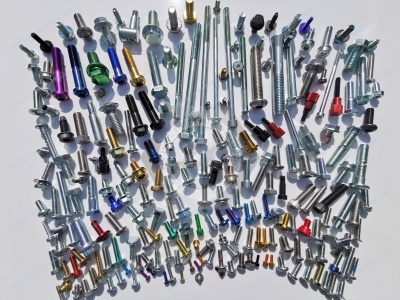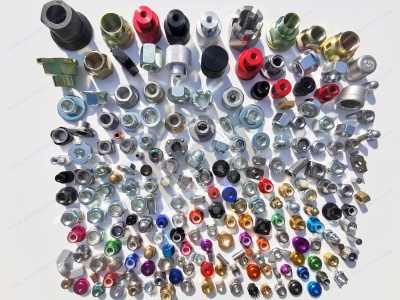Call Us
+86 136 6007 9809
Call Us
+86 136 6007 9809
Jul. 01, 2024
The whole process of hexagon head screw processing and production
Fasteners are known as the "rice of industry," which can be seen in their wide range of applications. Bolts are indispensable in daily life and industrial production and manufacturing. The bolt's application scope covers aerospace, transportation construction, electromechanical machinery, electronic digital, power engineering, home life, etc. Bolts in the industrial field can be said to be the cornerstone of existence. As long as humanity is still developing industry, bolts play a pivotal role.
Today, Juxin Fasteners will take you to reveal the whole process of bolt production and processing technology, a glimpse of the bolt from zero to one, from scratch to the production process. Bolt machining process: material selection - spheroidization (softening) annealing - shelling and de-scaling - cold dialing - cold forging forming - threading - heat treatment
18-8 Stainless Steel Flanged Hex Head Screws for Sheet Metal:18-8 stainless steel screws have good chemical resistance and may be mildly magnetic. They have a hex head for a secure grip with a wrench and a flange to reduce the risk of crushing thin metal. Screws penetrate 0.025" and thinner sheet metal. Length is measured from under the flange. Head height includes the flange.
High-Strength 410 Stainless Steel Hex Head Drilling Screws for Metal:410 stainless steel is strong, wear-resistant, and mildly chemical resistant. These screws have a hex head for a secure grip with a wrench and a flange to reduce the risk of crushing thin metal. They save you time and effort by drilling their holes and fastening in a single operation. Four hundred ten stainless steel screws are magnetic and not for use with aluminum. Length is measured from under the flange. Head height includes the flange.
Electrical Grounding Screws: The green color identifies these as grounding screws. They have a flange that provides a broad, flat surface for solid electrical connections. Screws cut threads in drilled holes as they're turned, so they require less driving torque and cause less stress on your material than thread-forming screws. Length is measured from under the flange. Head height includes the flange.
Steel Flanged Hex Head Screws for Wood: These steel screws are hot-dipped galvanized to resist corrosion in wet environments and are a good choice for ACQ-treated (arsenic-free) lumber. The flange reduces the risk of crushing material, and the hex head provides a secure grip with a wrench. They press threads into material for a tight, secure hold. To prevent splitting, drill a pilot hole slightly smaller than the screw. Head height includes the flange. Length is measured from under the head.


1. Material selection: Different materials are used according to the strength level of the bolt. The current market standard parts are mainly carbon steel, stainless steel, copper, titanium alloy, aluminum alloy, and other materials.
Carbon steel: carbon steel has excellent processability and can meet a relatively wide range of strength performance combinations, and with other fastener materials, the cost is also lower. The mechanical properties of carbon steel are sensitive to the carbon content, usually less than 1.0%. We often use the carbon content of carbon steel material to distinguish between low carbon steel (C% ≤ 0.25%), medium carbon steel (0.25% < C% ≤ 0.45%), and high carbon steel (C% > 0.45%), as well as alloy steels (in the plain carbon steel with alloying elements).
Stainless Steel
Performance Grade: A.45, 50, 60, 70, 80 Mainly austenitic (18%Cr, 8%Ni) Good heat resistance, corrosion resistance, and weldability.
B.A1, A2, A4 Martensite 13%Cr Poor corrosion resistance, high strength, good wear resistance
C. C1, C2, C4 ferritic stainless steel. 18% Cr was upsetting better than martensitic corrosion resistance.
D. Currently, imported materials are mainly Japanese products on the market. According to the level of the main points SUS302, SUS304, SUS316.
Copper is a commonly used material for brass and zinc copper alloys. The market mainly uses H62, H65, and H68 copper as standard parts.
2. Balling (softening) annealing
(1) spheroidizing (softening) annealing countersunk head screws, hexagon socket cylindrical head bolts produced by cold heading process, the original organization of the steel will directly affect the forming ability of the cold heading process, cold heading process of the local area of the plastic deformation up to 60% -80%, which requires that the steel must have good plasticity.
(2) For high-strength fasteners with more medium carbon steel and medium carbon alloy steel, spheroidizing (softening) annealing before cold heading is recommended to obtain uniform and detailed spheroidized pearlite and better meet the actual production needs.
(3) For the softening annealing of medium carbon steel coils, the heating temperature is chosen to keep warm above and below the critical point of the steel. The heating temperature is generally not too high; otherwise, it will produce three times the carburization body precipitation along the grain boundary, resulting in cold heading cracking.
(4) medium carbon alloy steel raw materials using isothermal spheroidal annealing, in AC1 + (20-30%) after heating, furnace cooling to slightly lower than Ar1, the temperature of about 700 degrees Celsius isothermal for some time, and then quenching furnace cooled to 500 degrees Celsius or so out of the air-cooled. The metallographic organization of steel from coarse to fine, from flaky to spherical, cold heading cracking rate will be greatly reduced.35\45\ML35\SWRCH35K steel softening annealing temperature of the general area of 715-735 degrees Celsius.
3. Stripping de-descaling. The heading steel coil removes the iron oxide plate process for stripping bright, and de-sdescalingere are two methods of mechanical de-descaling chemical pickling. Mechanical de-escalation of the coil's chemical pickling process improves productivity and reduces environmental pollution. This descaling process includes the aligning method (commonly used with triangular grooves of the wheel counter-bending coil), spray nine methods, etc., in addition to the scale effect is better, applicable to low-strength fasteners (less than or equal to 6.8 level) with carbon steel coil. High-strength fasteners (greater than or equal to 8.8 level) with an ending bar in the mechanical descaling to descaling the iron oxide, and then by chemical pickling process that is composite descaling.
4. Cold drawing: The cold drawing process has two purposes: to reform the size of the raw material and to deform the role of strengthening the fasteners to obtain the basic mechanical properties. For medium-carbon steel, medium-carbon alloy steel, there is a purpose, that is, to make the coil after the control of the cold sheet carburized body in the drawing process as far as possible rupture, for the subsequent spheroidization (softening) annealing to get the granular carburized body ready.
5. Cold forging: Bolt head forming using cold forging plastic processing. Compared with the cutting process, the metal fiber (metal stay line) along the product's shape was continuous, with no cut-off in the middle, thus improving the product's strength and giving it excellent mechanical properties. The cold heading forming process includes cutting and creating, which is divided into single-station single-strike, double-strike cold heading, and multi-station automatic cold heading.
6. Thread processing: bolt threads are generally cold processed so that a specific diameter range of thread blanks through the rolling (rolling) silk plate (mold), by the silk plate (rolling mold) pressure to make thread forming. The plastic flow of the threaded part can be obtained without being cut off, the strength is increased, the precision is high, and the quality is uniform, so it is widely used. The common point of rolling (rolling) thread processing is that the number of rolling revolutions does not have to be too much; if too much, then the efficiency is low, and the surface of the threaded teeth is prone to produce separation phenomenon or the phenomenon of messy buckle. On the contrary, if the number of revolutions is too tiny, the diameter of the thread is easily lost round, and the pressure of the initial rolling is abnormally high, shortening the mold's life.
7. Heat treatment: Heat treatment of high-strength fasteners according to technical requirements are to be tempered to improve the overall mechanical properties of fasteners to meet the product requirements of the tensile strength value and flexural strength ratio.
Due to the production of high-strength bolts and low price, threaded part is relatively fine relative to precision structure; therefore, the requirements of heat treatment equipment must have strong production compatibility, a high degree of automation, high quality of heat treatment characteristics to produce high-quality high-strength fasteners, advanced heat treatment technology, and equipment is indispensable. But fasteners in the tempering quenching process may appear to have quality problems, such as fire state hardness being insufficient, quenching state hardness being uneven, quenching deformation being super poor, quenching cracking, etc., which is often associated with the production of raw materials, quenching heating, quenching, and cooling, correctly formulated heat treatment process, standardize the process of production operations, you can often avoid such quality accidents.
I did not expect a small bolt production process to be so complex! To complete each process, advanced production machinery, experienced engineers, and related quality inspection staff were needed to check and supervise the quality of each bolt.
Although bolts are simple fastening parts, they are essential in large-scale construction projects. By understanding the process of producing and processing bolts, you can find the source to check the time limit for their use, timely replacement, and repair to avoid accidents.For high-quality Carbon Steel Hexagonal Head Screws&hex nuts and professional technical support, don't hesitate to contact us at adelajonly@gmail.com or visit our website at: https://www.juxinfasteners.com.
Contact Us
Tel.:
+86 020 8621 0320
+86 020 3121 6067
Technical Support:
Navigation
SEND INQUIREY